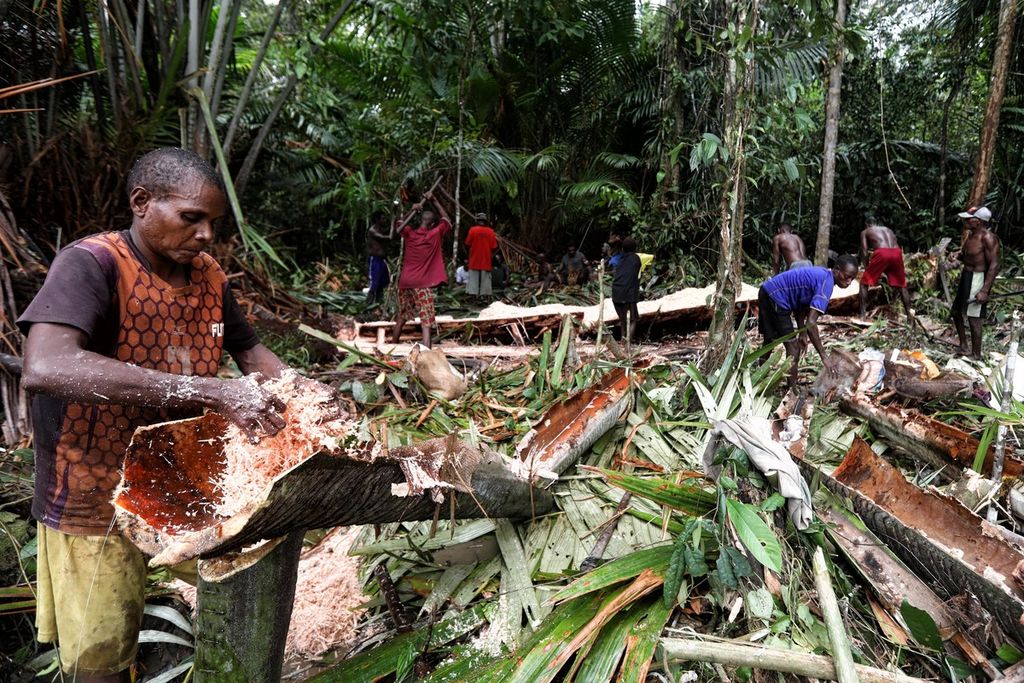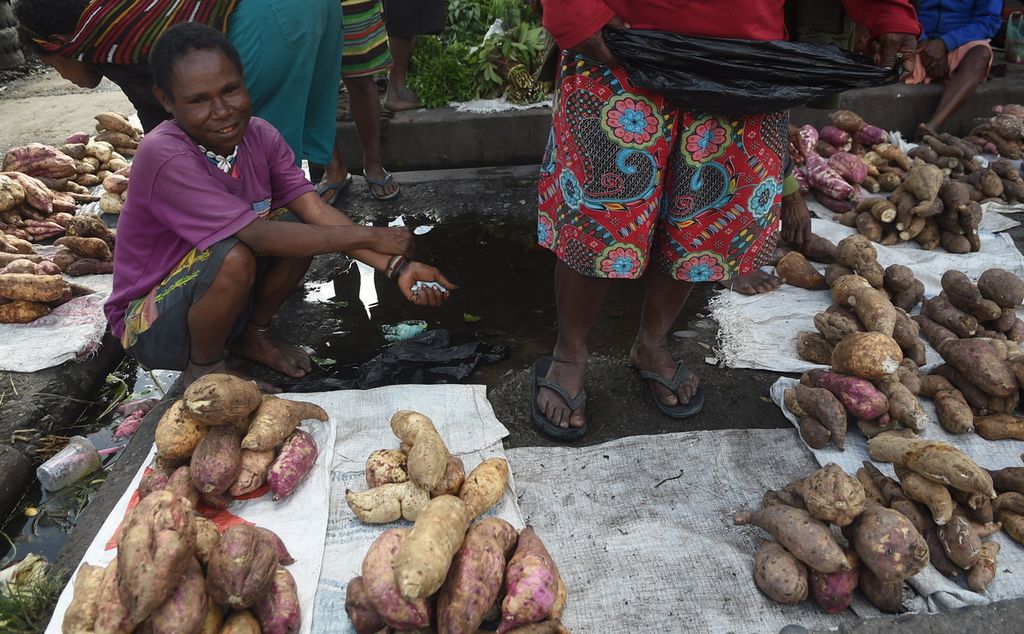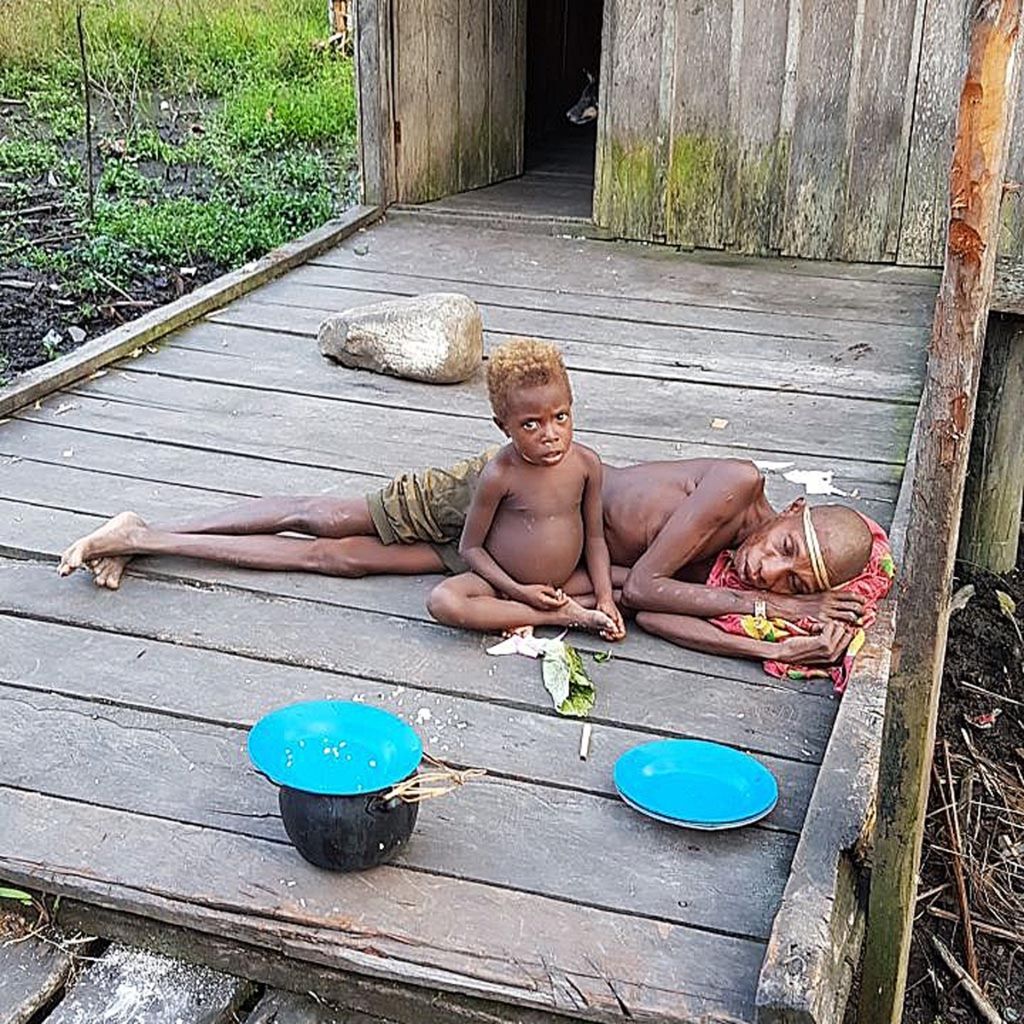Local Food Sustainability Under Threat
These two commodities were ubiquitous in remote areas of Papua, as the Papua Inroad Expedition team observed when visiting a number of areas in the easternmost province early 2020 until late 2021.

The process of filtering the pith or fibers of the sago tree to produce sago starch, Thursday (14/10/2021).
The shift in consumption habits of some indigenous people in Papua has led to an abandonment of local staple foods such as sago and sweet potatoes. If left unheeded, food self-sufficiency is threatened.
ASMAT, KOMPAS — Many indigenous Papuans now prefer to consume rice and instant food than sago and sweet potatoes. Not only has this shift in consumption habits left them highly dependent on food supplies from outside, the preservation of local food production and cultivation is now facing a steep challenge.
The community's dependence on rice and instant food also has an impact on the life and health of the local community.
People living in the lowlands or the coastal areas have relied on sago procured from natural terraces for generations, as those in the mountains have done on growing sweet potatoes.
Also read:
Sweet Potatoes No Longer Favorite
These two commodities were ubiquitous in remote areas of Papua, as the Papua Inroad Expedition team observed when visiting a number of areas in the easternmost province early 2020 until late 2021.
The shift in daily consumption habits has been triggered by the arrival of rice aid and the flooding of instant food from outside into various regions in Papua. People have since begun to switch consumption and neglect local foods. The lack of community knowledge in processing local crops has also made rice and “more seasoned” instant food preferable.
With the shift in consumption habits being inevitable, in Asmat regency, local people are rarely seen extracting sago from forests.
In meeting their food needs, some people rely on government assistance, both basic necessities and cash, as with the case of Daniel.
He used the money to buy food at the stalls in the neighborhood.
The resident of Er village, Sawaerma district, admitted that he fulfilled the food needs of his three children and his wife from the government’s aid package consisting of rice, eggs and instant noodles as well as Rp 1.6 million in cash. He used the money to buy food at the stalls in the neighborhood.
In a wooden plank-walled and sago leaf-roofed house consisting of two rooms and measuring 30 square meters, he lived with 11 family members.
Like other community members of the Asmat tribes in the village, Daniel's family used to go to the forest and harvest the crops, a tradition having been passed on for generations. However, they now rarely collect sago, hunt pigs or fish, even when food stocks run low. "The kids like noodles, they can be eaten instantly. If we have money, we buy them, or sometimes we just pick them up from the shop and pay later,” Daniel said.
In Boven Digoel regency, some of the Korowai tribal people have also begun to switch to rice. Opi Dayo (25), a Korowai living in the regency’s administrative center Tanah Merah, said he started to abandon sago and turn to rice when he moved from his hamlet to the town. In Tanah Merah, rice was cheaper and easier to obtain than sago.

Sweet potato seller at Tolikelek Market, Jayawijaya Regency, Thursday (11/18/2022). A number of residents are still growing various local sweet potato varieties that have been planted by Papuans.
Opi carried over his rice-consuming habit when he returned home to his hamlet in the outlaying Xanax village. Sago would be eaten only when there was no other choice. However, his tribal community still eat sago as their daily staple food. “I have eaten sago since childhood. Now if there is rice and sago, I choose rice," he said.
Rice has become an optional staple food since the central government launched the Raskin [rice for poor] program for villages in the early 2000s. The government distributed free rice on a regular basis, and local people have since become dependent. The majority of children living in the villages no longer eat sago.
Meanwhile, in Jayawijaya regency, people have also abandoned sweet potatoes, domesticated in their neighborhood plantation yards.
Also read:
Hoeing Sago in the hinterland of Boven Digoel
Fando Lokobal (18), a resident of Asolokobal district, Jayawijaya, said he preferred rice to sweet potatoes. He said would have rice in the early morning and then in the afternoon if the rice was still left over.
“Rice is more indulging now that we get used to it, eaten with sweet potato leaves it’s enough. If given the choice between rice and sweet potatoes, I choose rice," Fando said.
Declining production
Jayawijaya Agriculture Office head Hendri Tetelepta said that a shift in people's food consumption had raised concerns about food security, particularly as local crop fields were dwindling.
He said the local people’s consumption shift had affected sweet potato sustainability in terms of production, cultivation land and variety development in the Baliem Valley. With reference to several studies, he said the region had been home to more than 160 varieties of sweet potato before dropping to 68.
On the other hand, rice production increased sharply by over 60 percent, from 171 tons in 2015 to 293 tons in 2020.
The Jayawijaya Agriculture Office reported a decline in sweet potato production in the community that had occurred in the span of five years, from 86,141 tons in 2015 to 75,904 tons in 2020. On the other hand, rice production increased sharply by over 60 percent, from 171 tons in 2015 to 293 tons in 2020.
The shift in consumption from sago to rice and instant food in Asmat is also an irony given the vast sago land in Asmat. Based on the data at the Food Crops and Agriculture Office, the land for potential sago production in the regency amounts to 1.4 million hectares.
Apart from consuming instant foods, most of the people in the villages in Asmat are also reported to consume drinking water raw from the river, which is blamed for causing diseases, such as intestinal infections and poor nutrition.

A toddler is accompanied by his mother in the courtyard of the house in Kampung Adat, Pulau Tiga District, Asmat Regency, Papua. Throughout December 2017, dozens of children under five in Asmat District, died due to malnutrition and contracted diseases due to not receiving immunization services.
The Asmat District Health Office reported that as many as 5,806 residents suffered from intestinal infections in 2020, mostly complaining about diarrhea. The office also disclosed 134 cases of malnutrition in 2020, leading to the deaths of seven children. The cases unfolded to the extent that the government declared an emergency situation in Asmat in early 2018.
Asmat Health Office head Richard RB Mirino said that many residents still turned to rivers or swamps for drinking water, which leaves them, especially children, vulnerable to infectious diseases.
“Especially for kids, the digestive process can be disrupted. The [health] campaign that we conduct is to make them aware that food and drink must be cooked first,” Richard said. (IDO/CIP/JAL/VAN/KRN/ENG/ICH/ILO)
(This article was translated by Musthofid)